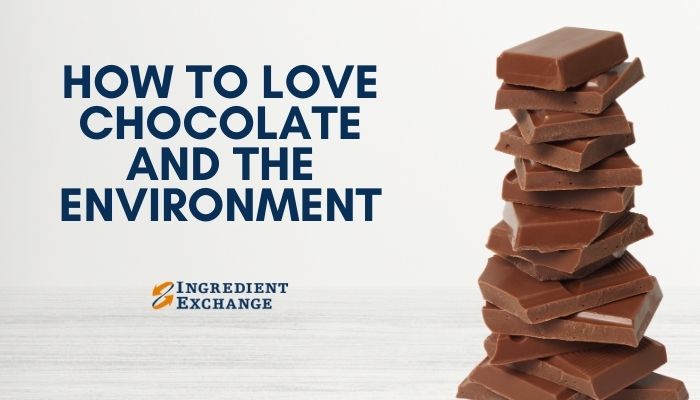Raise your hand if you love chocolate. Heck, raise both hands! Other than the very odd few (sorry, if you’re one of them!) almost everyone would unapologetically raise their hand as chocolate lovers.
To make it even better, there is good news for chocolate lovers across the world. As Ingredient Exchange commented in a recent article, the global chocolate market is predicted to grow a sweet USD $139.94 billion worldwide by 2024. It seems that people just can’t get enough chocolate.
However, there are some shifting consumer trends that those in the chocolate business should be aware of, and they chiefly concern the environment and sustainability. Don’t get me wrong: the desire for chocolate isn’t going anywhere, but, as always, we adapt to best serve our customers. And those consumers are becoming more aware of and concerned about some of the adverse effects manufacturing chocolate can have on the planet.
Starting at the source:
Most people say they would travel to the ends of the earth to find their favorite chocolate (and some of you probably have!). Conveniently for us, our favorite heart-shaped, bunny-shaped, and every-other-shaped chocolate does most of the world-traveling just to satisfy our sweet tooth.
A vast majority of the world’s chocolate supply comes from the very humid equatorial regions of West Africa and Central and South America. Of course, this means that in order for chocolate to be manufactured after it has been harvested, it has to travel significant distances first. This has led to some push-back from consumers who are increasingly seeking “local” sourcing, or at least as close as they can get.
To produce most of the large-scale commercial chocolate that is found in the local supermarket, deforestation is taking place in the rainforests, and this is never a good look for any business. To go along with this, the manufacturing also emits significant levels of carbon dioxide into the atmosphere. Consumers are looking for alternatives, and they are particularly fond of companies that are doing the same.
Americans consume over 2.8 billion pounds of chocolate per year, and milk chocolate makes up over 80% of all chocolate consumed. Milk chocolate can be especially harmful to the environment, because of the methane produced by large-scale cow farms in underdeveloped countries. An interesting side effect of this, however, is that, whereas it can be impossible to find “locally sourced” chocolate in America, there is certainly an opportunity for “locally sourced” milk.
Adverse effects also come from the inordinate amount of water used in the production of chocolate. One thousand liters of water are used to produce one chocolate bar.
The most stunning impact on our environment is from individually wrapped candy bars and especially bags of bite-sized candies (as if Halloween needed to become scarier!). The sheer amount of packaging and wrappers contributes to overall waste.
There are, as always, steps manufacturers and consumers can take in order to make the chocolate industry more environmentally friendly.
Utilizing the fruits of the chocolate.
The source of chocolate is in the form of Cacao, or more precisely, the cacao tree, from which the seeds are harvested and eventually become chocolate and cocoa. Cacao beans are essentially the bitter pits left after a thin layer of juicy pulp enveloping them evaporates through a sun-drying process. The pulp itself, however, has been described as tasting like a hybrid of a peach and mangosteen (a South American fruit), and it has been used by some chocolate manufacturers as a natural sweetener.
There are now manufacturers developing alternative uses by using the cocoa fruit.

Until recently, most chocolate has been made with the addition of refined sugars. Now, there is an opportunity to utilize the entirety of the cacao.Nestlé announced in July 2019 that it has developed an approach that allows it to extract the pulp and use it in chocolate, with no compromise on taste, texture, or quality. This patented innovation delivers a great-tasting chocolate using only one ingredient – the cocoa fruit.
That is a real bonus!
What should a consumer do?
In addition to limiting our own consumption, the most important thing we can do is to make smart choices about which chocolate we consume.
Eliminate individually-wrapped small candies, and walk away from those candy bars in the check-out lane. Although convenient, the convenience does not outweigh the drastically negative effects on the environment. Instead, look for sustainably produced and environmentally friendly chocolate producers. Not only will they make your conscience feel lighter, they almost always taste WAY better!
What about dark chocolate?
By choosing dark chocolate, you have chosen a great-tasting chocolate that also provides significant health benefits. Yes, you heard that right! Eating chocolate can be… healthy!
Dark chocolate from craft cocoa makers is a more environmentally friendly and healthier choice. Dark chocolate has even been linked to lowering blood pressure and the risk of heart disease. Reputable chocolate makers promote direct trade, small batches, and they also support the farms where the cocoa is grown. The overall result is chocolate that’s healthier for you, the farmers, and the planet. That’s a win, win, win!
So, in the end, making the conscientious choice and marketing those choices to an ever more savvy consumer base, will yield better results for the environment and your business as well.



